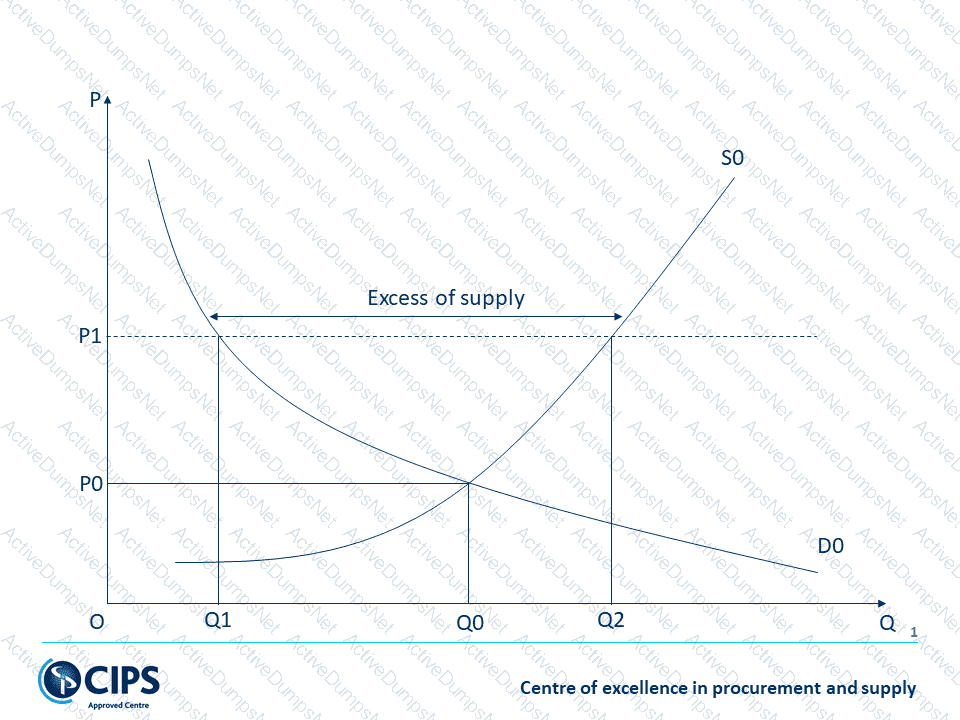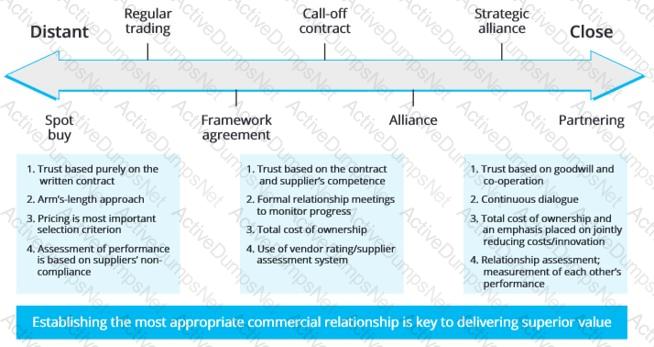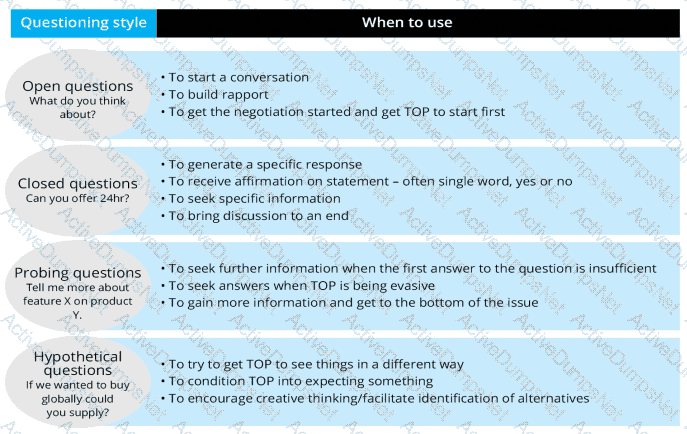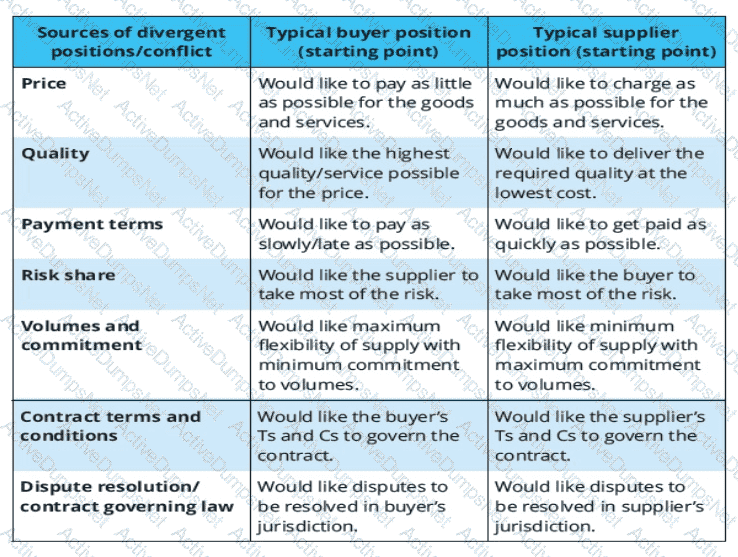CIPS L4M5 Commercial Negotiation Exam Practice Test
Commercial Negotiation Questions and Answers
A supplier can produce a product for $160 and sells it for $240, making $80 profit. What is the mark-up profit percentage?
Which of the following is most likely a consequence of falling interest rate?
A procurement manager has decided to bring in a junior member of their team to a negotiation meeting. Which of the following would be suitable roles for this junior member of the team?
Buyers should have the ability to analyse the costs of their purchases not only for determining their impact to their organisation's cost but also for the purpose of reducing them during commercial negotiations to contribute to the profitability of their organisation. One way of analysing costs is to classify them into direct and indirect costs.
Which ONE of the following is an explanation of 'direct costs'?
XYZ Ltd needs to purchase a bundle of IT products from suppliers. The procurement manager requests details of costs regarding designing and managing those products. After receiving reports from suppliers, she realises that they have charged up to a 1,095% mark-up on IT products. In order to ensure value for money, which of the following should be a priority pricing arrangement of the procurement manager in the negotiation with these IT suppliers?
Personal power is only used in distributive approach. Is this statement true?
Open questions can be a useful communication tool in negotiations. Is this statement correct?
A good negotiator invests time in understanding the needs of the individuals in a negotiation. Is this statement true?
When is an adversarial style of negotiation appropriate?
Amelia needs to negotiate prices with a potential client that she has not met before. She was due to attend their offices next week, but the meeting has been cancelled. The potentialclient has offered a telephone call as an alternative, but Amelia has declined the offer as she feels negotiations cannot succeed without a face-to-face meeting. Is this the right decision?
A procurement manager is considering accepting a fixed price agreement for 12 months with an IT supplier. What are the advantages of fixed price agreements? Select TWO that apply.
A competitive win-lose distributive approach to a negotiation is seeking to:
Which of the following are recognised techniques in contract negotiation? Select THREE that apply.
Jayden works as a procurement manager for a large IT organisation. They are currently in their third round of negotiations with an increasingly frustrated software solutions provider. Ben is representing the supplier. Jayden has made eye contact in the latestmeeting to confirm his understanding of each of Ben's points. What communication technique is Jayden demonstrating?
A procurement manager has decided to bring in a junior member of their team to a negotiation meeting. Which of the following would be suitable roles for this junior member of the team?
Note taker
Expert
Observer
Chair
Which of the following are most likely to help buyer become preferred customer in supplier's perspective? Select TWO that apply.
A skilled negotiator will use a range of questioning techniques in a negotiation. If they wished to explore options with the other party without making any formal commitment, which type of question style would they use?
Where there are high levels of commitment to relationships between both the buyer and supplier, this is seen as collaborative and beneficial to negotiations. Is this statement correct?
A building firm has been awarded a contract to construct an office block. Which is a direct cost?
Why is rapport building with the supplier important during the opening phase of a negotiation?
Where can we find the data on macroeconomics?
1. From trade journal
2. From supplier's marketing catalogue
3. From stock exchange market
4. From government's statistics
Different types of relationships impact commercial negotiations. At a negotiation, which one of the following sources would help to support leverage for the buyer?
Which of the following is an advantage of a fixed-price agreement?
A negotiation meeting between a buyer and supplier has taken several hours. Both parties believe the negotiation is starting to reach a close. Before the supplier makes their closing statements, they are most likely to be doing which of the following?
Which of the following are macroeconomic factors that may have influence to the commercial negotiation? Select TWO that apply
Jane is planning for a forthcoming negotiation with a key supplier. She has learned what are important to the supplier and what are important to her company from previous contracts between them. In order to avoid negotiation deadlocks, she has set up several concession plans. But Jane has little experience in dealing with suppliers and doesn't know when to trade these concessions. When is the best time in a negotiation to trade concessions?
Which of the following are most likely to be indirect costs of a garment manufacturer? Select THREE that apply.
Win-lose approach is most likely to be associated with which of the following type of relationship?
Which of the following occur in the planning and preparation stage of negotiation? Select THREE.
An adversarial style of negotiation is appropriate when the buyer has greater bargaining power. In what other situation may the buyer adopt this style?
A procurement manager has decided to bring in a junior member of their team to a negotiation meeting. Which of the following would be suitable roles for this junior member of the team?
Note taker
Expert
Observer
Chair
During a negotiation, Jose Gomez, the salesperson for a strategic supplier, states that his sales director will not approve discounts against initial purchases. However, Jose offers a 5% discount against the aftercare package, which will provide the same monetary saving. Sally Pampas requires both the product and the aftercare package and has an objective to achieve a 5% discount off the purchase price. To achieve a win-win (integrative) negotiation, Sally should ...
Lina Rawlins is a senior buyer working for a medical equipment company. Lina is in charge of the company’s largest supplier account, Great Barrington Gas (GBG), a medical equipment supplier. Recently GBG’s performance has declined, which has led to an increasing number of rejected items. Lina is aware of the seriousness of this, given the nature of the item, and has asked GBG to attend an urgent meeting. In the meeting, Lina asked the GBG representative “Can you tell me exactly what you are doing to ensure quality?” What type of question is Lina asking?
Any commercial negotiation process has only three stakeholders: procurement, budget holders, and users. Is this TRUE?
According to Dr. Mari Sako, which of the following is potentially the weakest trust to be built?
Which of the following are examples of variable costs?
Building and site rent
Annual insurance premium
Raw materials expenditure
Delivery costs for materials
A buyer has lost trust in a supplier but wishes to repair the relationship. What is the appropriate first step?
A procurement manager withholds important information to strengthen negotiating power. Is this appropriate when using an integrative negotiation style?
If the price of a good is above the equilibrium price, which of the following will happen?
Which of the following is the internal factor that is taken into price of a product?
Citywide Developments Ltd (CDL) is a construction programme management company that delivers high-value property development schemes. CDL uses named consultant design services in contracts. Recently, consultancy day rates have increased. Which of the following tradeable concessions could CDL offer when negotiating with suppliers to achieve lower rates, without lowering service quality?
The procurement manager of a private healthcare provider is running an IT project. Who would be the stakeholders?
General public
Pharmaceutical suppliers
Senior Management
Software support developers
In order to mitigate all risks involved in the negotiation process, the buyer only needs to undertake pre-negotiation research on the supply market and establish a BATNA. Is this a correct suggestion?
Which of the following will positively affect reputational strength of an organisation? Select TWO that apply.
In a commercial negotiation, a procurement professional believe that the larger the order quantity from buyer, the lower the supplier's average costs. Is this assumption true?
When is the best time in procurement process in which procurement should get involved so that the cost-saving opportunities are the greatest?
When might a buyer decide to use a distributive approach to a negotiation with a supplier?
Professional buyer is planning for the next negotiation of a simple one-off contract. This negotiation is typified by which of the following? Select TWO that apply.
Absorption costing is when the total cost per each unit of output:
Which of the following is an advantage of consultation as an influencing tactic?
Jessica Taylor, a senior buyer, is asked to create a written performance report after her latest negotiation. Which of the following should she include? Select THREE.
Which of the following two are recognized strategies to achieve a win-lose outcome?
Making the other party lower its resistance point
Making the other party think this settlement is the best it can achieve
Employ empathy to gain mutual understanding
Using compromise and creativity tactics
Active listening in negotiation includes which of the following activities?
1. Hearing
2. Interpreting
3. Rapport
4. Influence
What are the potential sources of conflict between the buyer and supplier? Select TWO that apply.
Which characteristics are likely to feature within an integrative negotiation?
Maximising the other party’s outcome to enhance relationships
Maximising joint outcomes
Short-term focus
Pursuit of goals held jointly with the other party
Which of the following is a disadvantage of absorption costing method?
In which of the following scenarios could you adopt a distributive-based negotiation approach?
After studying Thomas-Kilmann conflict resolution model and considering different approaches carefully, the procurement team of XYZ Ltd. decides to adopt an avoiding approach to the upcoming negotiation with one of their suppliers. Which of the following will be the objective of XYZ procurement team in this negotiation?
A buying organisation with a low spend but the reputation for paying on-time. In order to increase buyer's leverage in negotiation with suppliers, which of the following should be a priority of this buyer?
Macroeconomics can have an impact on commercial negotiations. Is this statement correct?
There are no commitments in hypothetical questions. Is this statement true?
Which of the following are most likely to turn buying organisation into an unattractive customer in supplier's perspective? Select TWO that apply.
A break-even analysis uses which aspects as part of the calculation?
Fixed cost
Buying cost minus variable cost per unit
Variable cost
Selling price minus variable cost per unit
A purchasing manager is having a negotiation with a supplier to extend the duration of the contract. In order to persuade the supplier to cut the cost by 10%, she promises to shorten the payment period from
45 days to 30 days for each delivery. The supplier's representative does not agree the offer and clearly states that his proposed price is already lower than the market price. The purchasing manager has
used which type of power?
Lina Rawlins, a senior buyer for a medical equipment company, is in charge of the company's largest supplier account. Recently, the supplier's performance has declined, leading to more rejected items. Lina has asked the supplier for an urgent meeting. In the meeting, she asks: “Can you tell me exactly what you are doing to ensure quality?”
What type of question is Lina asking?
Commercial negotiations on price cover various aspects, including pricing arrangements. A buyer may negotiate a fixed-price agreement. Why is a fixed-price agreement advantageous to the buyer?
It may be more difficult to buy on a credit from supplier who locates in a country with a hyperinflation? Is this assumption true?
Jayden works as a procurement manager for a large IT organisation. They are currently in their third round of negotiations with an increasingly frustrated software solutions provider. Ben is representing the supplier. Jayden has made eye contact in the latest meeting to confirm his understanding of each of Ben’s points. What communication technique is Jayden demonstrating?
An automotive company purchases high quality steel to produce components. The steel is an important raw material and the contract value is enormous. They sources the steel from oversea and contact some potential suppliers. One of the potential suppliers invites the procurement team to their premise for a new business opportunity. Should the procurement team accept the invitation?
A negotiation meeting between a buyer and supplier has taken several hours. Both parties believe the negotiation is starting to reach a close. Before the supplier takes steps to make their closing statements, they are most likely to be doing which of the following?
A procurement team has discussed, in advance of a negotiation, what they will do if there is no agreement with the current supplier. They have decided that they will perform the services themselves in-house on a trial basis if no deal is made. Which of the following describes what they have prepared here?
Which of the following would cause a demand curve for a good to be price inelastic?
“Finding the middle ground between buyer and supplier is a satisfactory way to complete contract negotiations.” Is this statement correct?
In airline industry, suppliers prefer to adopt dynamic pricing in order to constantly monitor and change their fares in response to market conditions. Dynamics pricing is based on which costing method?
In addition to organisational power, personal power of each negotiator can influence the outcomes of a negotiation. A good negotiator can leverage different sources of power. Is this statement true?
A skilled negotiator will use a range of questioning techniques in a negotiation. If they wished to explore options with the other party without making any formal commitment, which type of question style would they use?
John Browne, a junior buyer for a corporation, is analyzing the global supply market before undertaking negotiations and is wondering whether foreign exchange rates are important to factor into his research. Should John consider the foreign exchange rates?
A supplier’s mark-up on all products is 25%. Supplier's profit margin is...?
Which of the following is important during the proposing stage of a negotiation?
A procurement professional is dissatisfied with how a recent negotiation was concluded. What could they do to improve their negotiation approach?
Seek feedback from the supplier on their recent performance
Prepare for all negotiations with a WIN/LOSE (distributive) approach
Involve lots of people in future negotiations
Undertake reflective practice after each negotiation
John Browne, a junior buyer for a corporation, is analysing the global supply market before undertaking negotiations and is wondering whether foreign exchange rates are important to factor into his research. Should John consider the foreign exchange rates?
Which of the following are the most typical characteristics of integrative approach to negotiation? Select TWO that apply.
Effective listening is important in integrative negotiations. Is this statement correct?
Commercial negotiation ends at the award of a contract. Is this statement true?
Which of the following are effective approaches when procurement professionals negotiate with monopoly suppliers?
1. Delaying payment with monopoly suppliers as long as possible to increase bargaining power
2. Setting up stronger BATNA
3. Engaging in the negotiation with a distributive approach
4. Eliminating requirements in the specification that prioritises monopoly suppliers
Which of the following tactics would be appropriate in an integrative negotiation?
Which of the following statements about oligopoly is incorrect?
Which of the following is the purpose of using stakeholder support level scale?
Which of the following are examples of non-verbal negotiation? Select THREE that apply.
At which stage in a negotiation would questions be asked to obtain missing information?
A purchasing organisation wants a Win-Win (integrative) solution in negotiations with a key supplier. Which TWO approaches would be appropriate?
During a negotiation, the supplier requests for payment term shortened to 45 days from 60 days. Seeing that this proposal lies within the concession plan, the procurement manager asks for 5% discount in return. Is that right thing to do?
Which of the following are most likely to be the potential cultural differences that can make transactions with an international supplier more problematic that with local suppliers? Select TWO that apply.
Which of the following situations would increase a buyer's bargaining power?
Premium pricing strategies used by suppliers are characterised by which of the following? Select TWO that apply.
Which of the following are examples of variable costs?
Building and site rent
Annual insurance premium
Raw materials expenditure
Delivery costs for materials
Citywide Developments Ltd (CDL) is a construction programme management company that delivers the design and build of high-value property development schemes. CDL uses third-party consultant design services, using named consultants in the contract. CDL has recently observed increases in the consultancy day rate for these consultants. Which of the following tradeable concessions could CDL offer when negotiating with the suppliers of design services, in order to achieve lower rates of pay, but without lowering the quality of service?
A garden furniture supplier currently in negotiations for a high-value contract has offered the procurement manager a visit to their site. The supplier suggests that during this visit, they can undertake the contract negotiation. What would be an appropriate response from the procurement manager?
Which of the following are most likely to be sources of conflict that can emerge from the content of commercial negotiations? Select TWO that apply.
Ranjit is a facilities category buyer for a hospital in the UK and is managing an overseas sourcing project for security guard clothing and personal protective equipment. Ranjit is aware that foreign exchange fluctuations can create risk for his organisation and would like to remove this risk. Ranjit has asked the international suppliers to quote in GBP sterling. Will Ranjit’s approach remove the fluctuation risk for the hospital?
An organisation should develop different relationships appropriate to each supply situation. Which ONE of the following analysis methods could help identify these?
A procurement manager has been asked to procure 1,000 pens. He suggests to his manager that to obtain the best value for money, they should undertake a competitive bidding process. Would this be the best course of action?
John suggests that a post-negotiation review must involve a meeting with all stakeholders as the most effective method. Is this statement correct?
Using emotion as a technique of persuasion is ethical. Is this a true statement?
’What specific tests do you carry out to ensure quality is achieved?’ This is an example of which type of negotiation question?
In what circumstances is the bargaining power of suppliers likely to be high, in relation to buyer power? Select the THREE that apply:
A breakeven analysis uses which of the following aspects as part of the analysis?
Which of the following are tools that help procurement visualise cost breakdowns of products and services purchased from supplier?
1. Spend candlesticks
2. Spend tree
3. Aggregate expenditure model
4. Spend waterfall
Different types of relationships impact on commercial negotiations. At a negotiation, which one of the following sources would help to support leverage for the buyer?
A procurement manager is about to lead an important negotiation with a new IT supplier and has insisted the first meeting takes place at the buying organisation’s office. Will this give one party an advantage?
Which of the following is a description of mark-up?

 Chart, line chart Description automatically generated
Chart, line chart Description automatically generated Timeline Description automatically generated
Timeline Description automatically generated Text Description automatically generated
Text Description automatically generated Table Description automatically generated
Table Description automatically generated